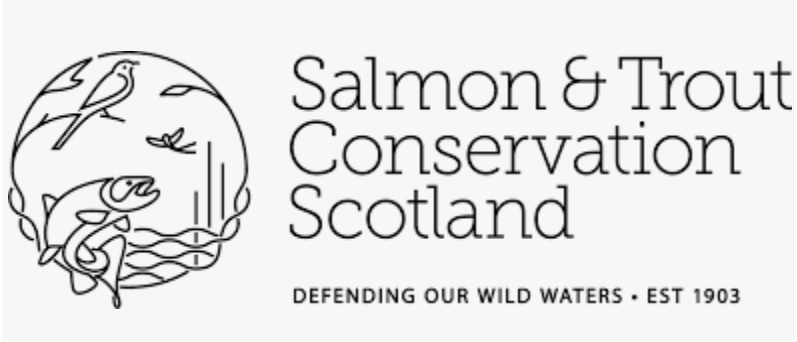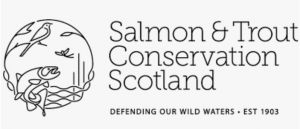Government response: According to Fish Farming Expert, the Scottish Government have issued their response to the Salmon Interactions Working Group report. I had already written this issue of reLAKSation when the news broke. I am also currently travelling. The Government’s response merits careful thought and probably an extensive full commentary so I will delay expressing my views for a week or two until I return to the office.
Thunderer: Last week, the Times newspaper’s Thunderer column was penned by Tavish Scott, SSPO Chief Executive, He wrote that a small number of angry – and not very well informed – voices keep claiming salmon farming is overwhelmingly responsible for the well publicised decline in wild salmon numbers. Whilst he is correct in saying that the narrative against salmon farming is orchestrated by a small number of angry uninformed voices, I would suggest that the majority of the wild fish sector shares their view but are happy to let this minority voice their opinions and take the flak whilst the rest stand by in the shadows.
Last November, Peter Pollard from SEPA told the Scottish Parliamentary Rural Economy Committee that sea lice from salmon farming were not responsible for the decline of wild fish stocks along the west coast, I have not heard this repeated or endorsed by anyone from the wild fish sector. In fact, I am sure that if I did not keep mentioning Mr Pollard’s statement, it would have been long forgotten. If sea lice are not the cause of the decline, then why are Marine Scotland Science continuing to work on a sea lice planning model for salmon farming? Why are they not devoting their time to pursing more of the other pressures that they have identified as causing problems for wild salmon across all of Scotland, rather than focus on the less than 10% of Scottish stocks found along the west coast?
Mr Scott wrote that one of these pressures is exploitation by anglers – a fact that the ore militant voices from the fringes of the angling world are loath to admit. Actually, Mr Scott is mistaken, Marine Scotland Science managed to avoid blaming anglers in their list of pressures. Instead, they refer to illegal exploitation rather than the so-called legal form. Their own concession to the inclusion of angling was to commission a PhD study on the level of mortality caused by catch and release. Although the study was completed some time ago, the results are not being made available until they are published in a scientific journal. This could take time and meanwhile fish are undoubtedly dying from poor catch and release practice.
Exploitation by angling is not considered a pressure on wild fish because as one of the comments written on the on-line version of the paper points out, angling does not have an impact on wild fish because most fish are now returned. The problem is that the decline of wild fish is not being caused by current practice but by the historic 5.9 million wild fish that have been killed over many years, significantly depleting the breeding stock.
Of course, the real problem is that wild fish strategy is primarily being governed by those in the wild fish sector and their supporters. I understand that when the first meeting of the wild salmon strategy group took place, much of the discussion was taken up by whether a representative of the salmon farming industry should be included in the group. Whilst the strategy is supposed to be about protection of wild fish, it is likely to be more focussed on protection of wild fisheries – because as we are told, angling activity doesn’t have any impact on wild fish stocks and if angling is not to blame then it must be salmon farming.
We know that Salmon & Trout Conservation are anti-salmon farming and are unlikely to admit that they have been wrong even if the most compelling evidence to the contrary is served to them on a plate, but I regularly hear that the other organisations now accept that salmon farming is only one of many problems. If that is true, then perhaps it is time for them to publicly say so. Perhaps, it is also time to endorse SEPA’s statement that sea lice from salmon farms are not to blame for the decline of wild fish or provide real evidence to the contrary. Why too are Marine Scotland funding Fisheries Management Scotland with an interactions manager if any interaction is minimal. Yet, the only public evidence of this role has been an objection to a farm planning application. Is this really, helping secure the future of wild salmon in the River Spey, Tay, Dee, Tweed and many other east coast rivers, whose numbers are no longer what they once were?
Stone deaf: Given that it was their petition that led to the Scottish Parliamentary inquiries into salmon farming, S&TC have taken little note of the follow up discussions by the Rural Economy Committee that took place last November. At that time, Peter Pollard from SEPA told the Committee that sea lice from salmon farming are not responsible for the decline in wild fish.
Last week, Andrew Graham Stewart, director of S&TC Scotland, wrote to the Fish Health Inspectorate, bemoaning that the lice levels at one farm site were too high and to enquire what the Fish Health Inspectorate were going to do about it. Of course, the only reason why Mr Graham Stewart knows about the lice level is because the salmon industry publishes the detailed data, which is a lot more than Mr Graham Stewart’s sector does. In addition, Mr Graham Stewart has requested a copy of any correspondence between the farm and the Fish Health Inspectorate under FOI. I suspect that Mr Graham Stewart is looking for a smoking gun but undoubtedly will be disappointed. The fact that Mr Graham Stewart has focussed on the fine detail relating to just one farms highlights that the industry, as a whole, is keeping lice levels under control.
I have been led to believe that the salmon industry has approached Mr Graham Stewart to request a meeting to discuss his concerns but apparently, he refused. Clearly, his concerns are not sufficiently great enough to actually address his concerns in person. I imagine that like most industry critics he wishes to avoid hearing facts that might undermine his long-established narrative. Salmon & Trout Conservation should consider pensioning off Mr Graham Stewart and moving on to address issues that actually are responsible for the declines of wild fish in Scotland.
Mr Graham Stewart’s blinkers approach to salmon farming is reflected in the current Salmon & Trout Conservation annual auction in which very few of the lots are offered by their Scottish members. S&TC Scotland are simply out of touch with not only salmon farming but also their own membership. Like other salmon conservation organisations, it is unclear why S&TC’s main funding raising activity involves hunting and catching for sport, the same fish they claim they want to conserve. Of course, their idea of conservation is about conserving the fish so they can catch them.
This year’s annual auction includes one lot that caught my attention. This is lot 106 which offers two days boat fishing on Loch Stack. The guide price is £250 but with three days (at the time of writing) of the auction left, the current bid is just £130.
The detail of the lot states:
“Loch Stack, at the head of the River Laxford, has long been amongst the best of Scotland’s Sea trout lochs.”
Whilst Mr Graham Stewart is able to freely access sea lice data from specific salmon farming sites, I am unable to obtain the catch data for Loch Stack, so I have no idea whether it has long been amongst the best of Scotland’s Sea trout lochs. Instead, I have had to rely on the annual data for the whole fishery district. Sea trout catches from the Laxford Fishery District are shown in the following graph up to 2014. These catches do not appear to support the view that Loch Stack is amongst the best of Scotland’s Sea trout fisheries.
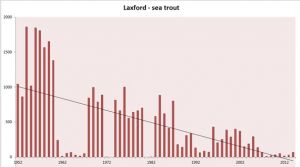
The most recent data of catches is even more difficult to obtain because since 2019, Marine Scotland Science has amalgamated catch data for many west coast fishery districts in order to protect the financial interests of the riparian owners, even though it is unclear how graphs such as that above can be translated into the various riparian returns.
Since 2019, Laxford was amalgamated with the Inchard and Inver Fishery Districts.
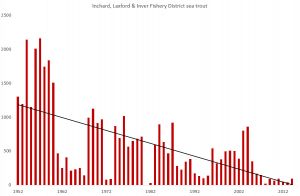
The trajectory is just the same as that of the Laxford Fishery District on its own. It certainly doesn’t help clarify whether Lock Stack is amongst the best of Scotland’s Sea trout fisheries.
Instead, I need to turn to Mr Graham Stewart for help. In February 2017, Mr Graham Stewart wrote in Trout & Salmon magazine to compare the Hope or Dionard to Loch Maree (or other formerly great sea trout lochs such as Stack which drain directly into sea lochs with salmon farms) where quality mature sea trout have been absent for decades.
Mr Graham Stewart described Loch Stack as a ‘formerly great sea trout loch’ and not unexpectedly, he attributes the loss of this status as being due to the presence of salmon farming.
This raises a couple of issues, not least why are S&TC describing Loch Stack as amongst the best sea trout fisheries in Scotland when their director says it is ‘formerly great’. Are they misrepresenting the potential of the fishing in the loch? Actually, they do say that sea trout of a pound and a half can be caught, which Mr Graham Stewart would not describe as a quality mature sea trout. Yet, at the same time, the catch data clearly shows that it is not just quality mature sea trout that are in decline. Catches of any sea trout appear few and far between.
Could Mr Graham Stewart be correct, and the decline is due to salmon farming. The first salmon farm in Loch Laxford and the surrounding area was registered on 22nd August 1985. Two years later on the 18-19 June 1987, the Scottish Government and the Scottish Marine Biological Association held a symposium at the Dunstaffnage Laboratory titled The Sea Trout in Scotland.
A paper by M. J. Picken presented at the symposium refers to Loch Stack. It states:
The north-west has shown a steady decline (in sea trout catches) with the highest catches in the middle to late 1950s.The region can be further examined with reference to different river systems, Historically, the name of Lock Stack was a password for excellence in sea trout circles. Before 1952, it was fished only by a few members of the proprietor’s family, the salmon fishing in the Laxford River possibly being the greater attraction. However, Young (1885) mentions that it was Scotland’s premier loch for sea trout in terms of numbers and size, Unfortunately, its reputation has bene eroded by a steady decline in catches from 1960-65 and again in the late 1970s.
Picken also provides a graph of sea trout catches from Loch Stack from the 1952 to the mid-1980s. He clearly had access to the returns from the loch which are submitted annually to the Scottish Government and form the annual statistics that continue to this date. This shows that the submissions hold a wealth of information about the state of wild fish stocks in Scotland that are denied to anyone working on this subject outside Marine Scotland Science. The wild fish sector has long demanded more information from the salmon farming industry but are very reluctant to share any data about their own sector.
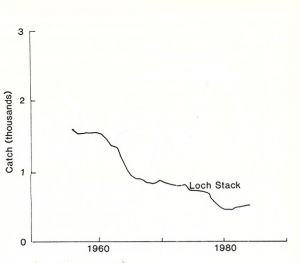
As I am unable to access any data about Loch Stack Sea trout catches, I cannot ascertain when quality mature sea trout disappeared from the loch but clearly, if catches of sea trout have declined, over many years, catches of mature sea trout will have disappeared along with the rest.
Mr Graham Stewart and others have long implied that salmon farming has destroyed the fishing, especially of sea trout along Scotland’s west coast. He has even specifically lamented the demise of Loch Stack and yet, here in 2021, his organisation is offering fishing on the loch as a lot in their fund-raising auction. It seems very much that S&TC have one message for their members and another for the rest of us. No wonder, he is so keen to deflect attention onto salmon farming.
Greenwashing: Sticking with Salmon & Trout Conservation Scotland, they are planning to accuse the Scottish Government of blatant greenwashing. This is because they have asked the Scottish Government to substantiate its claim that salmon farming is sustainable. I would expect that the Scottish Government will ignore S&TCs press release because the simple fact is that salmon farming is sustainable.
S&TC don’t consider salmon farming to be sustainable because they continue to believe that salmon farming is responsible for the decline of wild salmon and sea trout along the west coast of Scotland. As mentioned previously, S&TC wont actually talk to anyone who does not agree with them so it is impossible to demonstrate to them that they are mistaken.
They quote the UN Brundtland Commission as defining sustainability as meeting the needs of the present without compromising the ability of future generations to meet their own needs. As far as I can see that describes salmon farming. S&TC should perhaps look to their own activities and ask whether what they do is sustainable because it does seem that killing fish for sport is not something that will safeguard the future of the species. They might argue that in recent years increasing catch and release has protected stocks, but yet the killing continues albeit on a smaller scale.
However, it is not the issue of sustainability but rather greenwashing that I would like to discuss here.
S&TC Scotland have recruited the CEO of S&TC to support their claims. Nick Measham says:
“No amount of greenwashing can alter the evidence that open-net salmon farming kills wild fish and pollutes the marine environment. Sea lice and escapes from salmon farms are helping drive many populations of the west Highlands and Islands’ wild Atlantic salmon and sea trout to the brink of extinction. This alone is enough to demolish claims of sustainability without all the other impacts on marine life and the food chain being taken into consideration. This industry ranks amongst the worst environmental disasters in Western Europe.”
Unfortunately, S&TC have little comprehension of the issues because they only listen to themselves, However, what is interesting is that Mr Measham begins his claims by referring to greenwashing something that S&TC know all about because if anyone is guilty of greenwashing then it is S&TC.
Greenwashing is a form of spin in which green messages are deceptively used to persuade the public that an organisation’s aims and policies are environmentally friendly. In 2015, the then Salmon & Trout Association changed its name to Salmon & Trout Conservation.
At the time, S&TCs then CEO said that they have retained Salmon & Trout in our new name to maintain our contact with the past and also because salmon and trout are the favoured target species of our main supporters. They say that these fish are also ultimate natural indicators of the health of our rivers and lakes and thus if salmon & trout are thriving then there isn’t much wrong with the environment. If they are under threat, as so many wild stocks are today, then that is a clear sign that the water environment is struggling, and this is certainly because of human interference.
Of course, there is no mention that the most direct form of human interference is killing the fish for sport, and we know that since records began in our living memory, anglers have killed nearly 5.9 million wild fish from Scottish rivers. However, S&TC say that even though they are mainly supported by game fishermen, they must now start to show enlightened self interest by looking after the resource including the fish stocks. Yet, six years later, S&TC have yet to demand a ban on killing wild fish for sport.
S&TC say that although operating under a new name, their objectives remain the same. Yet if their objectives remain the same, then what is the point of the new name other than to mislead the public. If this is not greenwashing then I don’t know what is. Their main objective is to leave wild fish stocks in as healthy a state as our predecessors enjoyed. In that. they have certainly failed. This is not because of salmon farming, which they only use to deflect attention away from the fact that S&TC’s predecessors have overfished the wild stock to its current low levels.

